Summer eczema is the most common allergic skin condition in horses
Itching skin is the first and the most typical symptom of allergic skin. Allergy can have many causative agents. Insect bites cause allergic reaction to majority of the horses, even though only minority has summer eczema. Difference between the summer eczema horses and horses reacting allergically is the intensity of the symptoms and required treatment.
Veterinarian can best evaluate with you what is your horse allergic to and estimate the comprehensive clinical situation and define the right treatment.
Summer eczema is the most common allergic skin condition in horses. Horses are over sensitive to the saliva of the Culicoides insects, also called midges. These tiny insects live in wetland, by standing water (e.g. ditches) and are poor fliers, in dark they do not fly at all.
The allergic inflammation is an oversensitive reaction of the skin characterized by warmth, redness and with time hardening of the skin. Allergic inflammation causes itching, which causes horses to rub.
The rubbing cause further damage on skin, which can be infected. Head, ears, mane, tail and the dorsal midline are the symptomatic areas. The severity of the disease tend to worsen over time, specifically if the treatment is not sufficient.
The primary thing in the treatment of the allergy is to avoid the causative agent (environment, fly repellants, rug).
Good skin care involves keeping the skin clean and taking care of the skin’s moisture balance. The most effective treatment for summer eczema is glucocorticosteroids, cortisone. Cortisone suppresses the allergic inflammation. Cortisone can have severe side effects. However, it is an excellent medication when properly controlled by a veterinarian and currently the only medication in acute severe allergic skin reactions.
Also antihistamines are used in the treatment. However, their efficacy in horses is not explicitly evidenced scientifically. Homeopathic remedies have been shown to be effective for some horses. Skin requires adequate topical treatment, hence cortisone, antihistamine and/or insect rug is not alone sufficient treatment.
Information on product safety of animal care products can be found here.

Symptomatic areas on a horse with a summer eczema.
Print instructions in PDF format:
Video instructions
Below step by step directions for use of SOLHEDS products
Begin the treatment early, immeadetly after the first symptoms in order to manage the symptoms and avoid acute severe allergic reactions. During the active midge period treat your horse every day. At the start and end of the (midge) season less frequent treatment 3 or 4 times a week, may be sufficient. Wash the symptomatic skin with Derma1 Skin care shampoo when needed (1-8 times per month). Frequency can be assessed by the severity of the symptoms eg. when skin is damaged after rubbing (infection risk).
1. Keep the skin clean. The purpose of the washing is to wash off the causative agents of the skin decreasing the microbial load and to soothe and treat the skin. For repeating washes of sensitive allergic skin is water often sufficient. This way you can spare the skin from extra stress of chemicals and washing agents. Often only brushing is sufficient prior applying Derma2 Calming Serum/Derma11 Anti-Itch Spray on the skin.
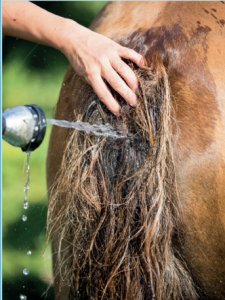
2. Rinse all dirt and wet the affected area carefully. Apply carefully Derma1 Skin care shampoo on affected area and leave for ~3 minutes. Rinse thoroughly.
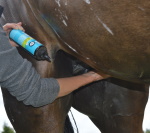
3. Let the area dry and apply Derma2 serum/Derma11 spray on the skin. Part the mane to expose the skin. Brush symptomatic ears and apply Derma2 serum. More support for the skin can be gained by applying Derma5 Germ Fighting Cream once a week or on the wash day. Derma5 Germ Fighting Cream is excellent for so called elephant skin e.g. tails rubbed to look like coarse brush.
Derma2 serum/ Derma11 spray is best suited for the daily treatment of allergic skin. In daily usage of Derma2 serum, a dandruff layer can develop signalling regrowth of the skin. Regular, gently brushing exposes the new regenerating skin, reapplying Derma2 serum maintains skins moisture balance and tolerance to external irritants.
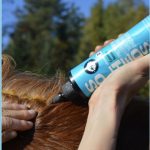
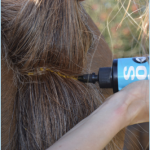
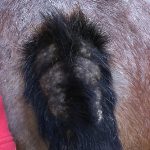
4. Spray or rub with sponge Derma3 cream/spray on to the hair approximately 2-5 cm away from the symptomatic areas. Spread the products to hair.
5. Veterinarian is required in acute allergic reactions, where horse has rubbed the skin broken, open wound. Veterinarian estimates the need for cortisone. Open wound is treated by washing with water and Derma6 wound oil can be sprayed to it.
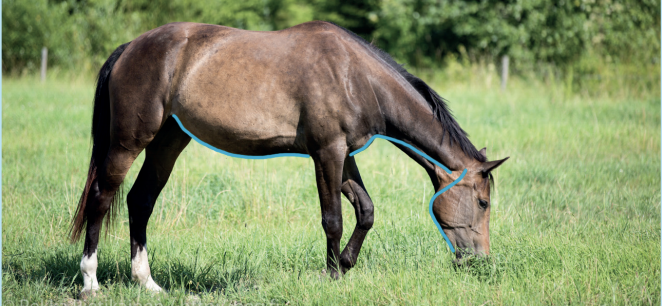
Typical reactive areas for insect bites.
The problems in treating horses with summer eczema are:
1.The treatment is not regular enough
2. Treatment does not reach all symptomatic areas
3. Treatment does not reach properly the skin
4. Insufficient hygiene
The care giver often restricts the treated area on what she/he can see. E.g. from mane only the area with hair loss is treated instead of the entire mane. It is common to see that the skin at the base of the entire mane shows signs of allergic reaction eg, inflamed skin with redness, warmth and hard skin. Broken insect rug implies of itchy skin requiring skin care. In chronic diseases like allergy, the basic care is good maintenance therapy, thus regular daily treatment. Horse owners will often need to arrange more care givers in order to provide daily treatment.
Allergic skin is sensitive and it does not tolerate harsh chemical nor mechanical stress. Use products you would be willing to use yourself on your own skin. Avoid greasy and dirt collecting products. Try taking the insect rug off from time to time e.g. in the middle of the day when there aren’t that many midges. Summer eczema is an allergic disease not a feature. The disease requires regular treatment in order to manage your horse’s painful itching and to control on the symptoms. Hindering the rubbing of your horse does not decrease the allergic inflammation, nor your horse’s itching. When treating your summer eczema horse monitor the condition of the skin also by palpating it, not just the hair. Well conditioned skin is soft, flexible and cool.
When treating a dog, horse or cat allergy, the animal’s allergy must be taken into account in all care. With regard to allergic skin, care products such as hair, washing and detangling must be as skin-friendly as possible. Typical problematic ingredients in animal care products are harsh detergents, e.g. sulfate-based, many preservatives, effective compounds and stabilizers. In SOLHEDS Derma products, chemical irritation to the skin is minimized. Here you can find instructions for skin-friendly washing of an allergic dog, cat or horse and here on grooming. Information on product safety of animal care products can be found here.
Many natural products can also cause an allergic reaction. Extra care is needed when treating allergic skin. The risk of a hypersensitivity reaction increases if the raw material used in the product is not pure and/or its concentration is high. The concentration of the harmful ingredients of this raw material can become too high and override the effect of the good effective ingredients making it unsafe to use. For example, the risk of resin products is the high natural resin content, which is a very common cause of allergies. Pitch oil and tar are carcinogenic products (cancer-causing) because of the PAH compounds they contain. Common health-promoting natural substances contain both good active substances and harmful skin-irritating, even dangerous substances. It is worth choosing natural products from a manufacturer who has professional knowledge and experience in these raw materials and understands what they are marketing. You can read more about product safety here.
Derma products are safe, long lasting as only small doses are used. The nozzle/tip cap helps in accurate and economical administration of the product.

